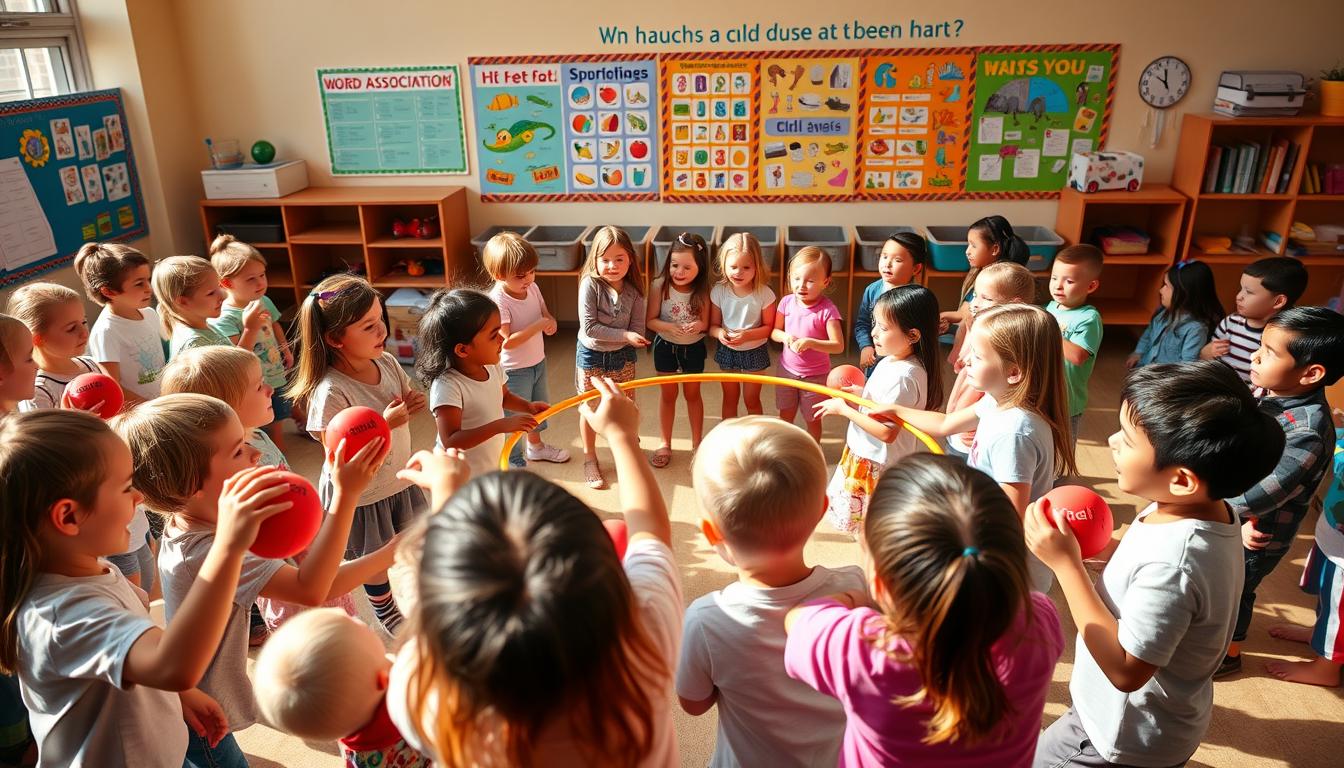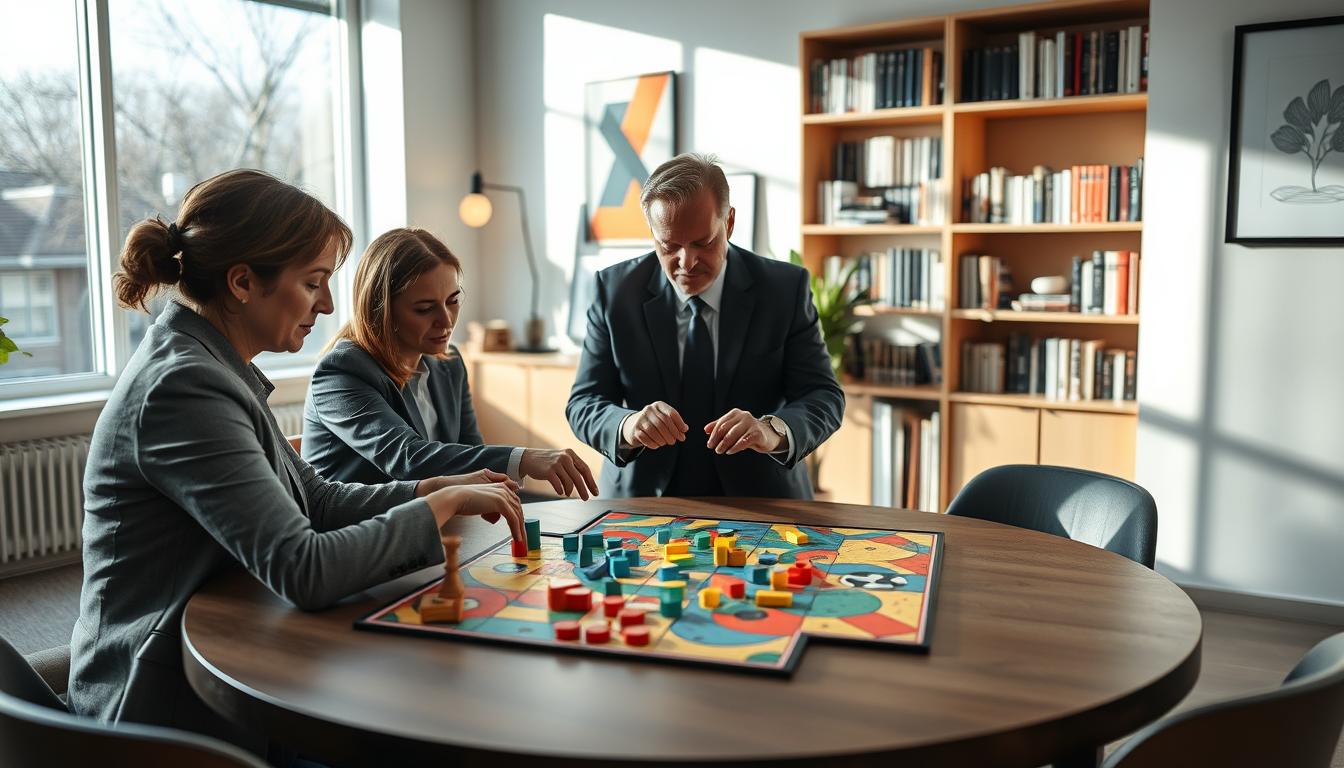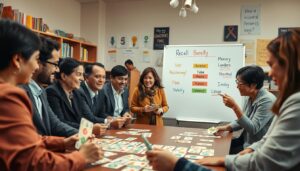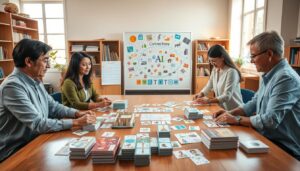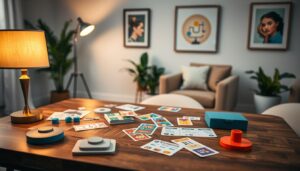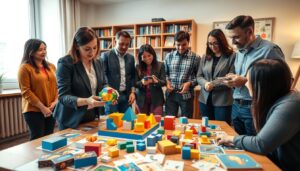Educational games combining word association and physical movement
Are traditional teaching methods holding students back from reaching their full potential in language learning? In the dynamic world of education, new strategies have emerged. Educational games are leading the way, mixing word association with physical movement. These games boost vocabulary and grammar while making learning fun for upper elementary students.
By combining brain challenges with physical activity, educators create a special atmosphere. This atmosphere promotes language skills, teamwork, and personal growth.
Introduction to Educational Games
Educational games are key in shaping students’ learning. They mix fun with learning, making it interactive. Students get to take part, feeling like they own their education.
These games come in many forms, like board games, digital apps, and physical activities. Each one grabs learners’ attention, making school fun. Students learn new things and improve their thinking and problem-solving skills.
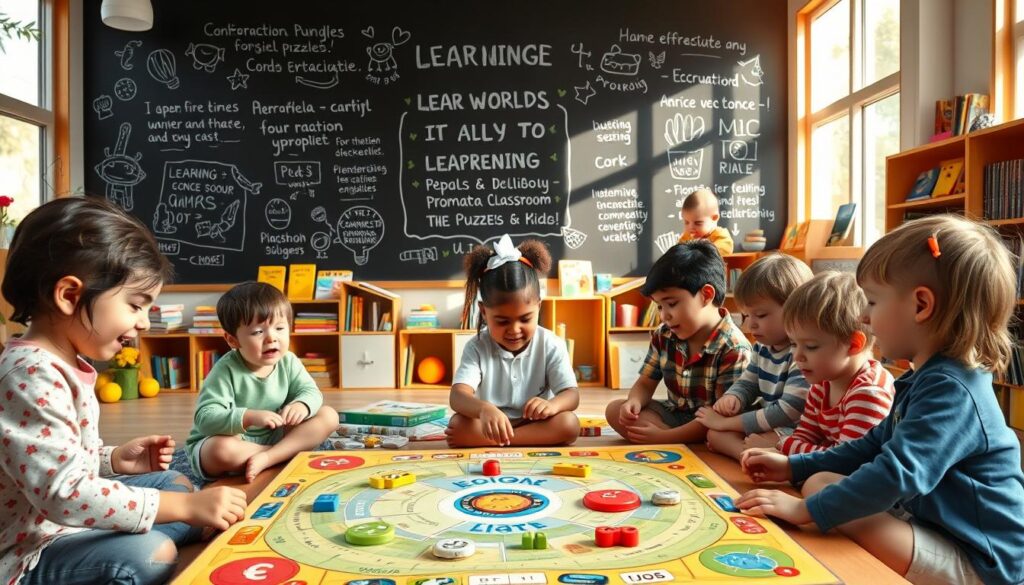
In short, educational games are a fresh way to improve learning. They focus on interactive learning. This helps students learn and grow in many ways.
Benefits of Combining Word Association with Physical Movement
Combining word association with physical movement brings many benefits, especially for kids. It makes learning faster and more fun. This mix of mind and body work together to boost learning.
Enhancing Cognitive Skills
Games that mix word association with physical activity help kids think better. They become quicker and more creative. By doing physical tasks, kids also learn new words and remember them better.
Improving Physical Health
Adding physical movement to word association games is good for both mind and body. Running, jumping, or dancing while learning improves heart health and strength. It’s a great way to stay active and healthy.
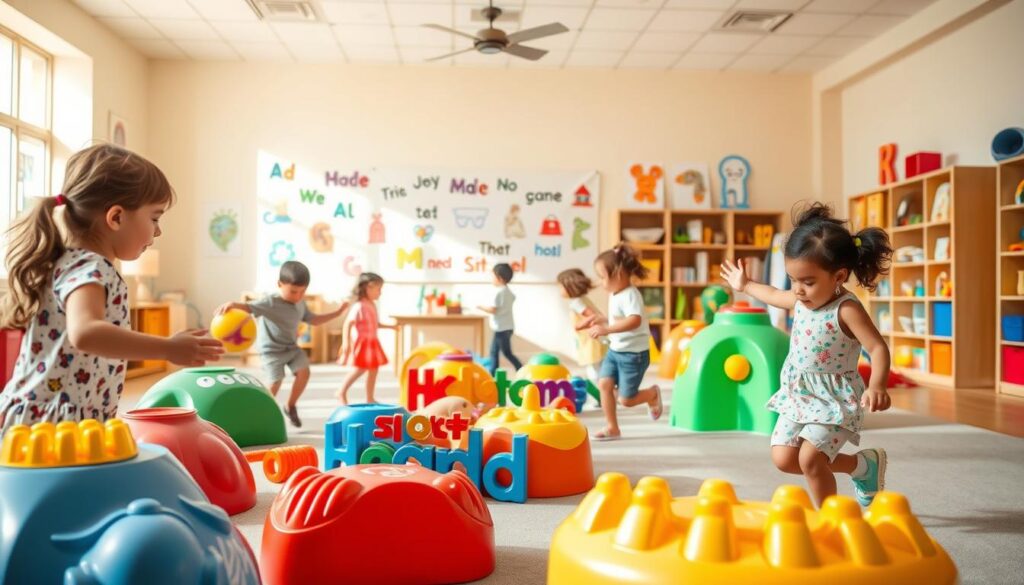
Types of Educational Games
Adding interactive games to the classroom can make learning more fun for students. There are many types of educational games that fit different learning styles. Here are some popular ones:
- Scavenger Hunts: These games get students moving and learning at the same time. Teachers can make hunts with specific vocabulary words.
- Word BINGO: It’s a fun spin on the classic game. Teachers can make BINGO cards with vocabulary words. This helps students remember words in a fun way.
- Charades: This game helps students work together and communicate. They act out vocabulary words or phrases. It’s a great way to learn through action.
These games make learning a fun experience. By using different materials and game types, teachers can meet the needs of all students. This keeps everyone engaged and excited to learn.
The Importance of Vocabulary in Learning
A strong vocabulary is key for learning languages and doing well in school. It helps students understand texts, share their thoughts, and talk clearly. With a good vocabulary, they can tackle tough subjects and learn more.
Why Vocabulary Matters
Vocabulary is more than just knowing words. It helps with reading, as students figure out what words mean in different ways. When students know many words, they can write better and make their points clear. A strong vocabulary also makes talking in class easier, helping students share their ideas.
Activities to Build Vocabulary
Teachers can make learning fun by using cool activities. These make learning words exciting and interactive:
- Word Jars: Fill jars with new words. Ask students to pick one and use it in sentences or stories.
- Synonym Games: Have students find words that mean the same as common ones. This grows their vocabulary and word skills.
- Story-Building Exercises: Get students to work together on stories using specific words. This boosts creativity and practical use.
A to Z Word Scavenger Hunt
The A to Z Word Scavenger Hunt is a fun way to learn new words. Players search for words that match each letter of the alphabet, based on a theme. For example, if the theme is animals, they might find words like “alligator,” “bear,” and “cat.”
This game boosts teamwork, creativity, and vocabulary skills. It’s a great way to learn and have fun at the same time.
How to Play This Game
To start, pick a theme that fits the players’ age and knowledge. Form teams and give them an alphabet chart. They have to find words that match the theme before time runs out.
This game makes learning exciting and fun. It’s a race against the clock. Give points for each word found and set a time limit to add to the thrill.
Adaptable Variations for Different Age Groups
The game can be adjusted for different ages. Younger kids might learn colors or shapes first. Older students can explore more complex topics like historical figures or science terms.
Change the team size and scoring to make it more interesting for everyone. This way, the game can be enjoyed by all, no matter their skill level.
Synonym BINGO: A Fun Way to Learn
Synonym BINGO is a fun classroom activity that boosts vocabulary through games. Students get BINGO cards with different words. When the teacher calls out a word, players find synonyms and mark them on their cards.
This game helps students understand word relationships better. It also makes learning more engaging and interactive.
Teachers can make BINGO cards more interesting by using themes or specific vocabulary lists. This makes the game relevant to the current lesson and keeps students excited. By doing this often, classrooms become lively places for learning synonyms and improving language skills.
Word Associations Chain: A Strategy for Learning
The Word Associations Chain game is a fun way for students to improve their language skills. Players form a circle and take turns saying words that connect to the last word. This game helps students think fast and make word connections, which are key in learning.
Setting Up the Game
To start the Word Associations Chain, follow these steps:
- Gather everyone in a circle so they can all hear.
- Choose a starting word and decide the direction.
- Each player must say a related word quickly, usually in five seconds.
- If someone takes too long or repeats a word, they’re out. This encourages quick thinking.
- Keep playing until only one player is left. Then, celebrate their win.
Benefits of Group Participation
Playing the Word Associations Chain together helps students learn in a group. They work together to find words, which helps them understand and remember vocabulary better. This game also improves communication and encourages positive interactions.
Engaging Sentence Scramble Activities
Interactive learning gets a boost from sentence scramble activities. These games mix up words to form correct sentences. They help students understand sentence structure and work together in class.
Materials Needed
Teachers need simple items for this activity:
- Sentence strips or cards with words on them
- A timer for a challenge
- Markers for color-coding parts of speech
- Visual aids for younger learners, like images matching the sentences
Game Variations for Different Skill Levels
There are ways to adjust the game for all skill levels. Younger students get simpler sentences with more pictures. Advanced learners can try harder sentences or make their own from given words. Here are some variations:
| Skill Level | Sentence Complexity | Additional Challenges |
|---|---|---|
| Beginner | Simple, 3-5 words | Use images as cues |
| Intermediate | Compound sentences | Add a timer to speed up play |
| Advanced | Complex sentences | Encourage sentence creation |
Physical Movement with Grammar Detectives
The Grammar Detectives game is a fun way for students to learn and move at the same time. It turns boring grammar lessons into exciting activities that make the classroom lively. Students search for different parts of speech around the room, which helps them understand grammar better.
Teachers can set up areas for students to find nouns, verbs, and adjectives. This makes learning grammar fun and keeps students active. It’s a great way to improve both their grammar skills and their health.
Teachers can give clues to help students find the hidden parts of speech. This game is like a scavenger hunt that encourages teamwork. It makes learning fun and keeps the material interesting.
| Activity | Description | Benefits |
|---|---|---|
| Grammar Detectives | Students locate parts of speech around the class. | Enhances grammar knowledge, promotes teamwork. |
| Noun Hunt | Find and categorize nouns in a playful way. | Encourages movement, builds vocabulary. |
| Verb Tag | Tag a classmate while exemplifying verbs. | Increases physical activity, reinforces learning. |
Mixing movement with grammar learning makes the classroom exciting. It makes students want to participate more. This approach not only makes learning fun but also helps students understand English better.
Verb Charades: A Dynamic Approach to Learning
Verb Charades is a fun way for students to learn action verbs through acting. Players act out verbs, and their friends try to guess. This makes learning verbs a memorable experience.
This game boosts creativity and teamwork. It makes learning vocabulary fun and effective.
To start, make a list of action verbs for your students. Split them into teams and have them act out verbs silently. This game helps students improve their vocabulary skills through acting.
Verb Charades makes learning exciting and fun. It combines movement with word recognition, helping students in different ways. It encourages creative thinking and deepens language understanding in a lively classroom.
Preposition Performance: Learning Through Acting
Preposition Performance is a unique way for students to learn about prepositions. It turns abstract grammar into fun acting activities. Students act out sentences with props and cues, like “The cat is under the table.”
This hands-on approach makes prepositions easier to understand. It makes learning fun and interactive.
Grammar games become more engaging with acting. Students not only remember the rules but also see how prepositions work in sentences. This mix of movement and words helps students connect better.
Teachers can use many props and settings for these activities. This makes learning fun for everyone, no matter their learning style.
Preposition Performance is a lively way to learn language. It makes grammar exciting and memorable for students.
Brain Games with Verbal + Physical Training
Educational games that mix verbal skills and physical activities are a fun way to learn. They keep kids engaged and help improve their thinking while keeping them active. This mix of mental and physical activities helps kids grow and remember better.
The Balance Between Mental and Physical Engagement
Brain games and physical activities are key to a great learning experience. Games that challenge the mind help with thinking, memory, and creativity. Activities that get kids moving improve coordination and strength. Together, they make learning a complete experience.
Examples of Effective Activities
Many activities combine brain challenges with physical action. Here are some great examples:
- Charades: This game makes players act out words or phrases. It boosts vocabulary and creativity and gets them moving.
- Scavenger Hunts: These hunts mix exploration with problem-solving. Players search for hidden items based on clues, improving their thinking skills.
- Memory Games: Adding physical actions, like hopping or jumping, to memory games makes them more fun and active.
Creative Storytelling Activities for Language Learning
Creative storytelling is a fun way to learn languages. It helps people work together and share ideas. Activities like Story Circles make everyone’s story better, improving their language skills.
By taking turns in a story, learners get better at telling tales. They also learn new words in a fun way. This makes learning a language exciting and interactive.
Adding props or pictures to stories makes them more real. This lets learners show their creativity and practice speaking. It helps them understand language better and builds friendships.
Follow the Leader: Learning Through Movement
Follow the Leader is a fun way to improve listening skills. It makes players focus on the leader’s physical commands. By mimicking these commands, they get better at coordination and following directions.
Physical commands are key to the game. They help players link what they hear with what they do. This mix makes learning fun and engaging.
Adding interactive activities to learning makes it exciting. Follow the Leader shows how listening and following directions can be fun. It helps kids and adults alike enjoy learning and improves their listening skills.
| Activity | Focus Areas | Age Group |
|---|---|---|
| Follow the Leader | Listening Skills, Physical Commands | All Ages |
| Obstacle Course | Coordination, Teamwork | 6-12 Years |
| Simon Says | Attention, Receptive Language | 3-8 Years |
Other Interactive Language Games
Playing fun language games can really help students improve their listening skills. Games like the Whisper Challenge and Match the Sound make learning fun. They help students talk better and understand what they hear.
Whisper Challenge and Listening Skills
The Whisper Challenge is all about passing on a secret message quietly. It teaches students to speak clearly and listen carefully. It’s a great way to improve listening skills in a fun way.
Match the Sound for Auditory Learning
In Match the Sound, students match sounds with pictures. It helps them learn to tell sounds apart and understand new words. These games show how learning a language can be both fun and effective.
Conclusion
Educational games that mix word association with physical movement make learning fun and effective. They help students learn new words and improve their language skills. These games also encourage kids to move and interact with others.
Interactive learning goes beyond just sitting in a classroom. It makes students active learners. They enjoy learning through games that challenge their minds and bodies. This way, they pick up language skills in a fun and engaging manner.
In short, using educational games in language learning is more than a trend. It’s a smart way to teach students important skills. By using these games, teachers can create a learning space that sparks curiosity, creativity, and teamwork.
FAQ
How do educational games enhance learning outcomes?
Educational games mix word games with physical activity. This makes learning fun and interactive. They help students improve their vocabulary, grammar, and speaking skills, especially in upper elementary school.
What are some examples of educational games that combine movement and word association?
Games like the A to Z Word Scavenger Hunt and Synonym BINGO are great examples. They make learning both fun and active. Word Associations Chain also combines mental and physical challenges.
How does physical movement benefit learning and cognitive skills?
Studies show that moving while learning boosts results. Games that need quick thinking and coordination help improve memory and creativity. They also enhance academic performance.
What are the advantages of using games in the classroom?
Games make learning interactive and fun. They engage students and offer different teaching methods. Games also promote teamwork and improve language skills.
How can vocabulary development be integrated into educational games?
Games like word jars and synonym games help with vocabulary. They make learning new words fun and interactive. This helps students understand and remember words better.
Are there adaptations available for different age groups in educational games?
Yes, many games can be adjusted for different ages and skills. For example, the A to Z Word Scavenger Hunt can be easier for younger students or harder for older ones.
How does the Word Associations Chain game enhance student skills?
The Word Associations Chain game boosts quick thinking and word connections. It’s a team effort that fosters a supportive learning environment. Students learn from each other.
What materials do I need for engaging Sentence Scramble activities?
You’ll need sentence strips or cards with words for Sentence Scramble. These materials make the game easy to play. They help students learn language skills in a fun way.
How can movement be incorporated into grammar lessons?
Games like Grammar Detectives turn grammar lessons into scavenger hunts. Students find and learn about parts of speech. Verb Charades and Preposition Performance use movement to teach action words and prepositions.
What are some additional games to enhance listening skills in students?
Games like the Whisper Challenge and Match the Sound are great for listening. The Whisper Challenge improves communication by passing messages quietly. Match the Sound helps students recognize sounds and improve listening skills.
